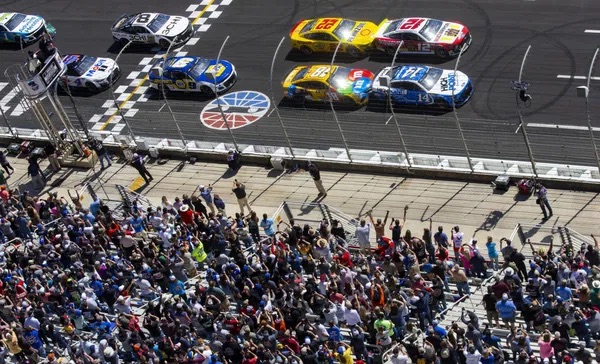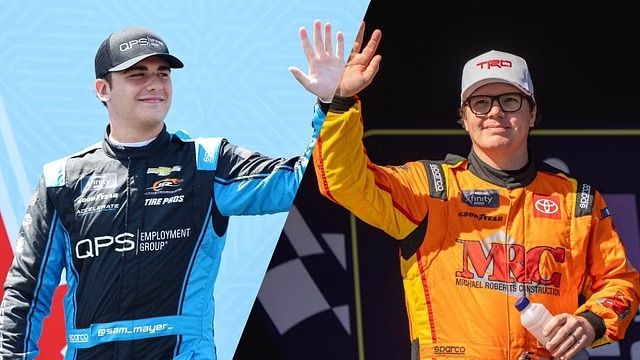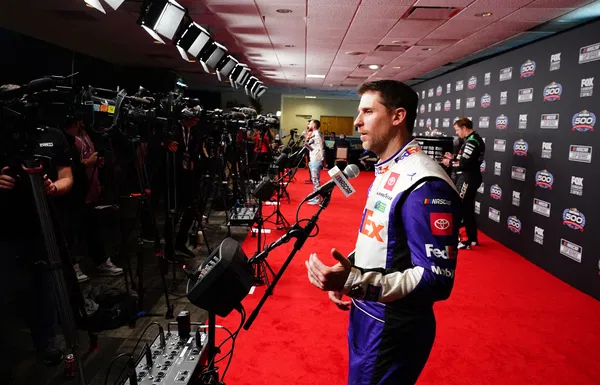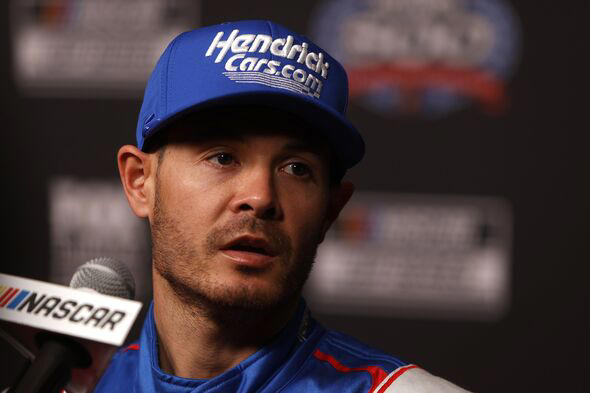The Quaker State 400, held this year in Atlanta, came with the quirky title of “Available at Walmart,” but the humor surrounding its branding quickly gave way to an unexpected, chaotic twist that left both drivers and fans in disbelief. With just ten laps remaining in Sunday’s Playoff opener, a seemingly harmless Walmart banner flew off a billboard, resulting in a caution flag that dramatically altered the course of the race.
Ty Gibbs and Daniel Suarez were locked in a fierce battle for first place, with Kyle Busch trailing closely in third. Just as the competition was heating up, the sixth caution of the day was called. However, it wasn’t for the usual reasons like debris or a wreck—it was for a rogue Walmart sign that had come loose and was flapping across the front stretch of the Atlanta Motor Speedway. Track officials, working frantically to remove the banner, took nearly five laps to resolve the issue. During this extended caution period, Gibbs and Busch lost their critical track positions, while Joey Logano, who had been running in fourth, capitalized on the situation. When the race resumed, Logano surged ahead, securing a victory and punching his ticket to the Round of 12, while Suarez and others were left struggling to regain momentum.
The aftermath of this bizarre event sparked a whirlwind of discussions across the NASCAR community, particularly on the “Door Bumper Clear” podcast, where spotters analyzed the situation. Brett Griffin, who was substituting as Austin Dillon’s spotter after a controversial suspension of Dillon’s team at Richmond, voiced his frustration in no uncertain terms. Griffin initially joked about the coincidence of a Walmart sign disrupting the race, humorously picturing fans in their pajamas watching from the stands. However, his tone quickly turned serious as he criticized the handling of the situation, specifically calling out Speedway Motorsports Inc. (SMI), which owns Atlanta Motor Speedway, for failing to securely fasten the sign in the first place.
Griffin wasn’t shy about expressing his disappointment, asserting that the improperly secured sign “ruined the race with 11 laps to go.” He took particular issue with how long it took NASCAR to address the problem, citing that the extended caution period significantly disrupted the competition. He argued that in 2024, ensuring trackside advertising signage is secure shouldn’t be a complex task, especially when the integrity of the race is on the line. As the podcast conversation evolved, Griffin posed a deeper question: “Who’s accountable when something like this happens?” He pointed out that NASCAR is responsible for the race itself, but SMI manages the track. This raised the issue of potential consequences, with Griffin suggesting that NASCAR should fine SMI for the disruption. However, he added a caveat, noting the dilemma of NASCAR potentially fining an entity that’s so closely tied to its operations. In his words, “NASCAR can’t fine itself, can it?”
Former Senior Vice President of Competitions Scott Miller had previously shed light on NASCAR’s decision-making process when it comes to calling cautions for debris. Following a similar controversy at the Firekeepers Casino 400 in Michigan, Miller explained that when debris is unidentifiable and poses a potential safety hazard, the organization leans toward caution. This approach appears to have guided the decision to throw a yellow flag for the Walmart sign at Atlanta. However, Brett Griffin and many other race observers felt that this particular incident was mishandled, causing unnecessary delays that altered the trajectory of the race.
On the same podcast episode, TJ Majors, another seasoned spotter, provided a slightly different take on the incident. Majors explained that cars racing at speeds upwards of 190 mph create intense air turbulence, especially on superspeedways like Atlanta. He argued that this kind of turbulence can easily dislodge objects from the trackside, implying that incidents like the one involving the Walmart sign are sometimes unavoidable. Majors admitted that while the incident was unfortunate, he wasn’t overly bothered by it, suggesting that trackside signage will always be vulnerable to such forces when cars race at those speeds. However, his somewhat relaxed attitude didn’t sit well with everyone, as some listeners felt the disruption had serious implications for the playoff contenders.
What seemed like a minor issue at first—a sign falling off a billboard—ended up having wide-reaching consequences for the drivers, fans, and NASCAR officials. The fact that a simple piece of advertising material could change the dynamics of such an important race left many fans scratching their heads. Ty Gibbs and Kyle Busch, two drivers who had been in strong positions before the caution, lost valuable ground that they couldn’t recover. Meanwhile, Joey Logano was able to capitalize on the situation, claiming victory and securing his spot in the next playoff round. The entire sequence of events, from the sign falling to the lengthy caution period, threw the race into chaos, forcing drivers to quickly adjust their strategies while also stirring up significant controversy off the track.
This incident at Atlanta Speedway underscores the importance of securing the race environment, even when it comes to seemingly trivial things like advertising banners. As NASCAR continues to refine its approach to safety and race management, it’s crucial that they learn from moments like this to ensure that future races aren’t impacted by such disruptions. Whether or not NASCAR will take action against SMI, as Brett Griffin suggested, remains to be seen. But one thing is certain: the unexpected drama at this year’s Quaker State 400 will be remembered for years to come as one of the oddest moments in recent NASCAR history.




